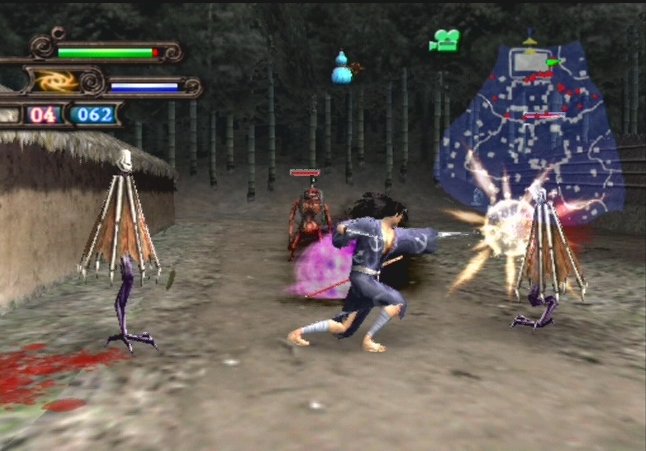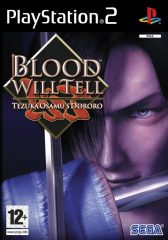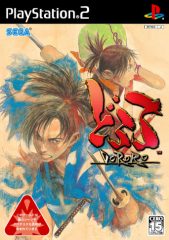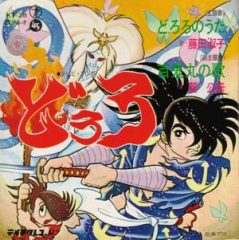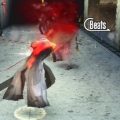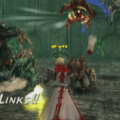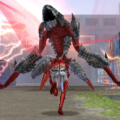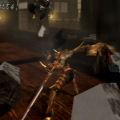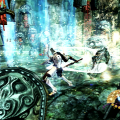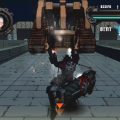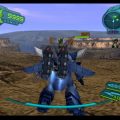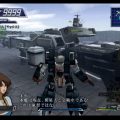What’s the first thing that comes to mind when Osamu Tezuka is mentioned?
If you are even remotely into animation or animation history, then Astro Boy is probably what immediately springs into your head. Tezuka created many prolific and famous characters and stories, including Black Jack, Kimba the White Lion, and many others.
However one of his darker works was the subject of a 2004 game from Sega (developed by Red and Overworks) when they had the license to make some games based off of Tezuka’s properties. Three games were made in this time period – two were based on Astro Boy, one of which was a 3D action title from Sonic Team that was not overly well received, but playable. The other was a highly praised 2D scroller from famous Japanese developer Treasure. But these two games aren’t my focus – this article will focus on the lesser known of the three Sega games – Osamu Tezuka’s Dororo (also known as Blood Will Tell outside of Japan). From here on in I will refer to it by its Japanese name, Dororo. Dororo started out as a manga series in 1967 in Shukan Shonen Sunday as a weekly serial (later retitled to Hyakkimaru and Dororo due to the main character’s popularity) and ran for less than a year until Tezuka stopped making it. Unfortunately, the story never ran to a conclusion. But being a dark themed manga with horror and fantasy elements made it ripe for the burgeoning anime market.
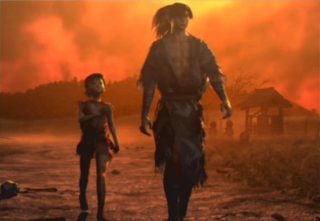
Blood Will Tell (PS2)
Dororo is the story of Hyakkimaru, a young man who is in search of the 48 fiends (demons) who have his missing body parts. As it turns out, Hyakkimaru’s father – Kagemitsu Daigo – had made a pact with an evil group of demons – if they can have the body parts of his first-born child, he will be granted rulership of Japan. Kagemitsu makes this deal with the devil and finds himself in power. However, when the boy is born and he sees what has happened to him, he takes his crippled son, sticks him in a basket and tosses him down the river. A healer named Jukai finds the horribly disfigured newborn and takes pity on the small creature.
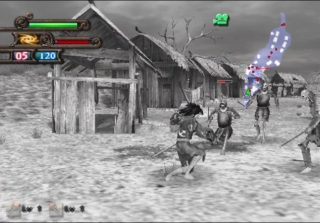
Blood Will Tell (PS2)
Over the next few years, Jukai learns Hyakkimaru has strange and special gifts, and even though they are visited (and threatened) by demons and other creatures, he is not dissuaded from his goal of creating a body for the young boy based on his knowledge of science and medicine. Knowing that the boy cannot speak (except through mental communication), see, or hear through conventional means (he can do both of these because of his supernatural gifts he possesses), he builds the boy a body, so he can have a semblance of a normal life. Hyakkimaru learns to run and jump like normal boys with his new body, Jukai knows in time he will have to build Hyakkimaru a new body and weapons when he is grown to be able to combat the demons that mean to destroy him.
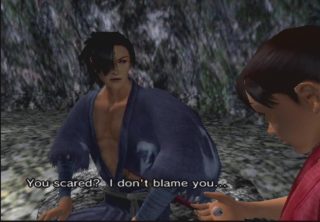
Blood Will Tell (PS2)
Dororo is a typical hack and slash game of the 3D variety. However, there are a lot of things that make it stand out from the pack of this genre. For starters the high quality CG scene that starts out the game is a nice preview of the things you will see in the game. (and maintains that quality throughout with the in- game and CG cutscenes.)
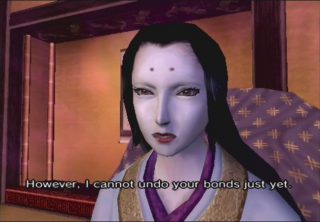
Blood Will Tell (PS2)
Like many modern action titles, there are some RPG elements mixed in, as Hyakkimaru’s sword arms (his prosthetic arms conceal swords) become more powerful as you use them. Also, as Hyakkimaru gets stronger, he gets access to longer and stronger combo attacks. Hyakkimaru also has a machine gun built into his right arm that he can use for ranged attacks, as well as a large cannon built into his right knee that causes massive damage to enemies, and can also be used to destroy certain parts of the landscape. However, both of these weapons have limited ammunition that needs to be replenished either by breaking pots and other destructable objects in the game, or by getting high combos in the game via Hyakkimaru’s charged attack.
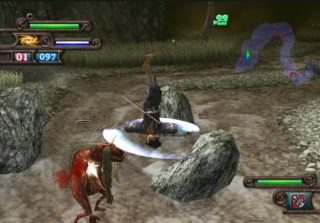
Blood Will Tell (PS2)
Hyakkimaru has a charge attack (press and hold the strong attack button, then release) when executed it goes into a large string of button presses (X, O, or Square) and a limited input time in which to enter them. Before time runs out, you must press the Triangle button to successfully complete the combo and possibly earn some nice bonuses. These include food, ammunition, or green spheres, that are used in giving Hyakkimaru the magic medicine to resurrect him should he get killed.
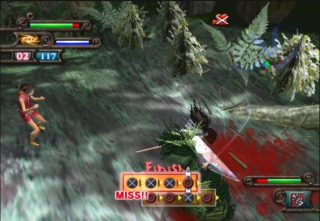
Blood Will Tell (PS2)
In many parts of the game, Hyakkimaru is accompanied by Dororo, whom he rescues at the beginning of the game. When fighting side-by-side, Dororo is controlled by the CPU (unless you have a friend and a second controller, then they can control Dororo for you.) You have limited commands you can give to him – by pressing and holding O then the D-Pad in the direction of the command you wish to use. Dororo can attack enemies (he has a health bar, although he is technically invulnerable, which can be advantageous in boss fights), and can also gather up items for Hyakkimaru, leaving you to concentrate on attacking the enemy.

Blood Will Tell (PS2)
You’re also forced to play as Dororo in a few segments. As Dororo is only a small boy, he’s pretty weak, but still has a surprisingly large amount of moves. Some of oddly named attacks include the Dororo Uppercut and Dororo Kick (yelled out during each attack in true anime nature), although he also attacks by throwing rocks, and with a rolling attack which makes him invincible. It makes for a nice change of pace and you aren’t stuck playing as him for extended times, but he can be annoying as he can’t take the same punishment that Hyakkimaru can. Fortunately, he can build up his life gauge by gaining hearts that act as life level ups for him.
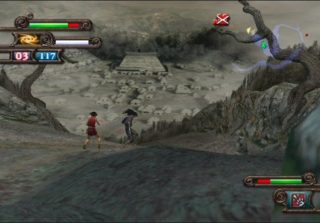
Blood Will Tell (PS2)
The game contains seven stages – however, there are many areas that are inaccessible due to Hyakkimaru not having the power, special weapon or sword needed to enter to these areas, which are mostly contain hidden fiends. In fact, i’s imperative that you revisit these areas in order to beat the game, as you must collect Hyakkimaru’s missing body parts to meet the final boss.
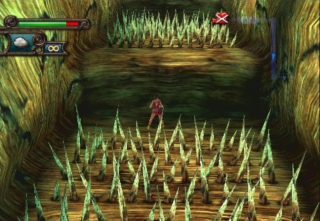
Blood Will Tell (PS2)
As being a game in the feudal era of Japan, it contains samurai swords…lots and lots of samurai swords. Hyakkimaru can collect over 30+ swords throughtout the story. Each one has a unique ability, whether it be a ice sword, or a blade that protects the user from poison. There is a sword for every occasion and most have unique looks to them as well as sword swipe patterns, showing great attention to detail was put into this game.
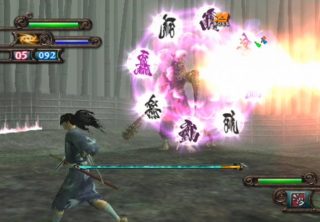
Blood Will Tell (PS2)
Speaking of the bosses – there are tons of them. How many other games will you get to fight 48 bosses? I don’t think I’ve ever played one with so many. A lot of them are carbon copies of each other, like different looking ogre bosses and flying enemies, but there are some unusual ones like Hindu-based statues, multi-tailed foxes, possessed stone wheels, a tentacled monstrosity, and a moth-like boss. This game gets major props for quantity and quality of different boss encounters, ranging from total pushovers to major challenges
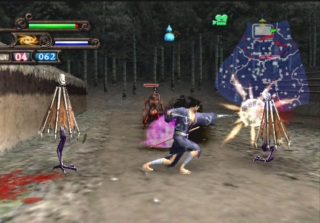
Blood Will Tell (PS2)
Also when Hyakkimaru gains certain body parts, he gains special abilities not yet available to him earlier in the game. For instance, when he regains his left leg, he gains the ability to dash (by pressing the L3 button, and controlling him can be tricky) but when you need to get some place fast, you will be using it quite frequently later in the game. Also when he regains his arms, his sword arms fall off and he gets that sword as a conventional weapon, but now as an extension of what he had before. (This is important as Hyakkimaru has two different move sets one with a regular sword and one with his sword arms, which is a more high flying aerobatic attack).
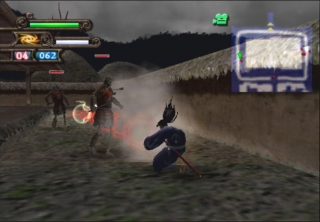
Blood Will Tell (PS2)
There are plenty of details in the graphics, from Hyakkimaru’s tattered kimono to the disgusting tendrils of one of the fiend bosses this game has it all. However, the backgrounds are mainly desolate empty villages, forests, temples and pagodas, so there’s nothing extravagant to see, but it fits the setting perfectly. All in game art was headed up by the acclaimed character design artists at Red Entertainment (famous for Gungrave / Gungrave: Overdose) and is visually similar to Tezuka’s own work.
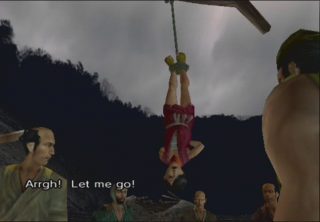
Blood Will Tell (PS2)
Another cool feature is that when you start the game, all of the graphics are black and white. This is due to Hyakkimaru not being able to see the real world, as it is only in his mind’s eye (how trippy.) It doesn’t last long in the game, but I was blown away by how cool this effect was and wished it was available later as an unlockable, which sadly it is not. It just goes to show how much the creators cared about the game and making it special.
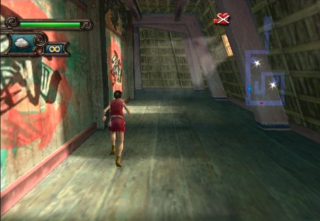
Blood Will Tell (PS2)
The audio is pretty decent too. It starts off by first class voice acting, something a lot of people complain about in games today. Hyakkimaru sounds strong and determined, Dororo sounds annoying, but fitting for a mischievous boy of his age. The sound effects of the swinging, slashing, gunshots, and explosions and again are spot on. The music is mostly ambient in town segments, and only really picks up during boss fights and works quite well for what is there.
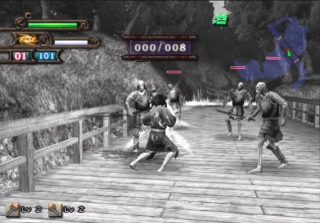
Blood Will Tell (PS2)
Since Tezuka never got around to finishing his story in the manga and anime, this led to a small problem, as the game had to have an ending, and none was available from either source. So Red and Overworks had to come up with a reasonable solution and therefore make one up. As not to spoil it, I think it works fine, even though I slightly disagree with how they handled it.
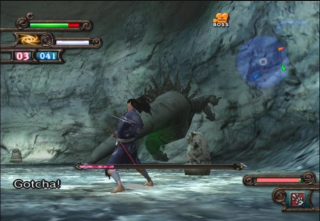
Blood Will Tell (PS2)
After completing the game and defeating all 48 fiends, you are given some unlockables to view, including a full monster encyclopedia, all game movies unlocked (including all of the important body part acquisitions and other story points), a special minigame called Dororo Mode (a timed collection game, which can be infuriating at times, but that has to be beaten to unlock the remaining bonuses), and a picture gallery which showcases character art as well as a large picture of all 48 demons in the game, including a boss so big you only get to see his hands. For a game that prides itself on the number of boss fights in it then how come a boss rush/battle mode was left out. Even though it is a small complaint it is something that many people wished was included in the game, myself included.
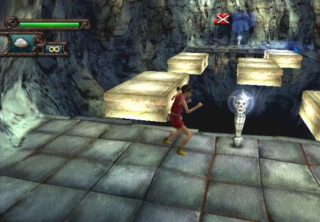
Blood Will Tell (PS2)
The game is not without its share of flaws, the main one is with the in-game camera. You will get very acquainted with the manual camera reset very quickly (L1 button) but in certain circumstances you cannot move it as it is locked in which can be very frustrating at times. There is also a boss fight camera that locks onto the boss enemy to help you keep track of where the boss is at all times. The controls and some of the attack combos can be frustrating for some players who are not as nimble fingered as others (especially during the combo trials or when doing a charge attack) they are not without a learning curve, but when you get proficient at them you will slice and dice through enemies without a second thought.
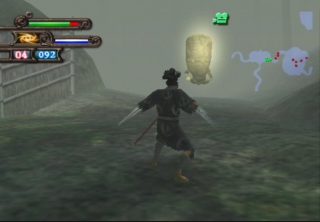
Blood Will Tell (PS2)
As with many action games, all of the fighting can get repetitive, killing the same enemies time after time. While not a long game (my total playtime spent is around 17 hours to fully complete it), but it can get a little long in the tooth , especially if you spend too much time powering up your swords, which really isn’t required anyway.
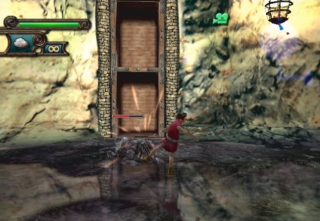
Blood Will Tell (PS2)
Blood Will Tell received very little hype, and was barely advertised at all. If you look anywhere online you will generally find mostly praise for the title but also something else, these words usually accompany the reviews and comments “underrated/hidden gem/the game you’re not playing/unappreciated” and that is a shame. The game apparently did well enough in Japan for them to issue a “The Best”, undoubtedly due to associated with the Tezuka name – but since this was based off a manga no one in America was familiar with, this was lost on the Western audience.
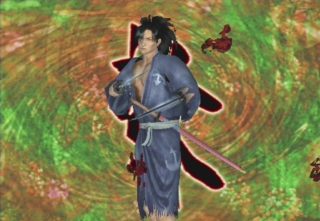
Blood Will Tell (PS2)
So if you have any faint interest in this genre, high quality games, or just wanting to pick up a PS2 game that you might have missed or didn’t know anything about before here’s a game for you. Pick it up and give it a go, in no time you’ll be calling out “Dororo!!!” just like I do when I play.
Links:
Dororo Official Website
Next Level Preview of the game from E3 2004.
Characters
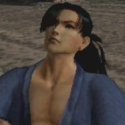
Hyakkimaru
A young man who hunts down the demons who stole his 48 body parts as an infant, leaving him massively deformed. He only looks normal due to a body created by his surrogate father. He has a power that the demons fear. In addition to wielding blades in his arms, he also has a cannon in his arm and a rocket launcher in his knee.

Dororo
The boy thief who wishes to grow up big and strong like Hyakkimaru, and wants a sword of his own, preferably Hyakkimaru's. Kind of small and whiny, and terrible at fighting, although he can toss rocks.
